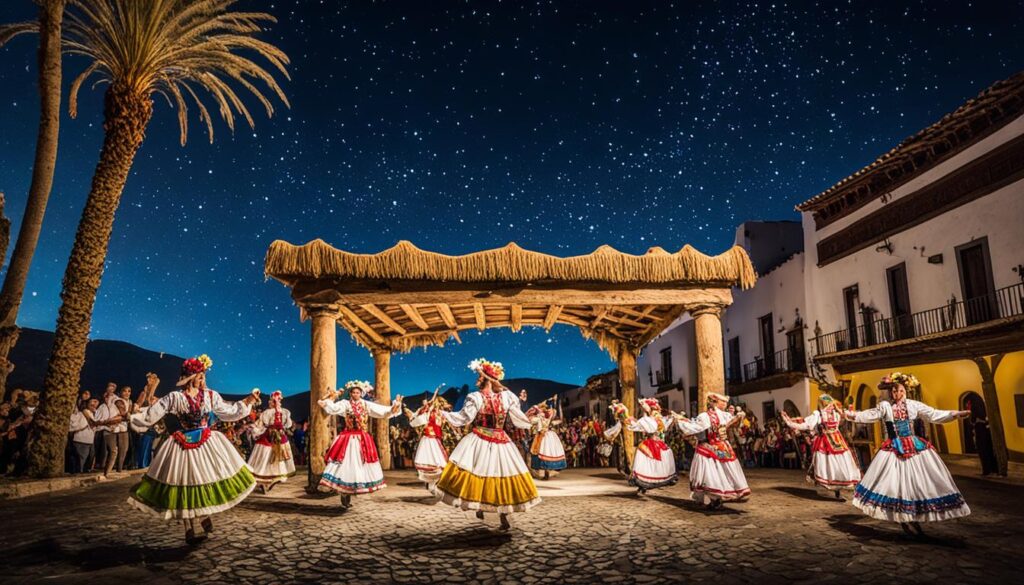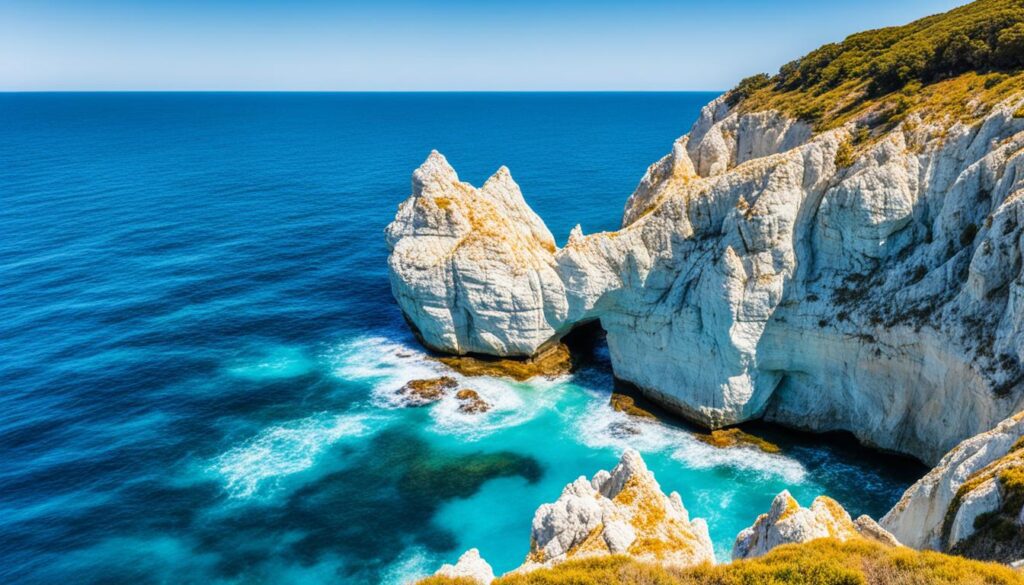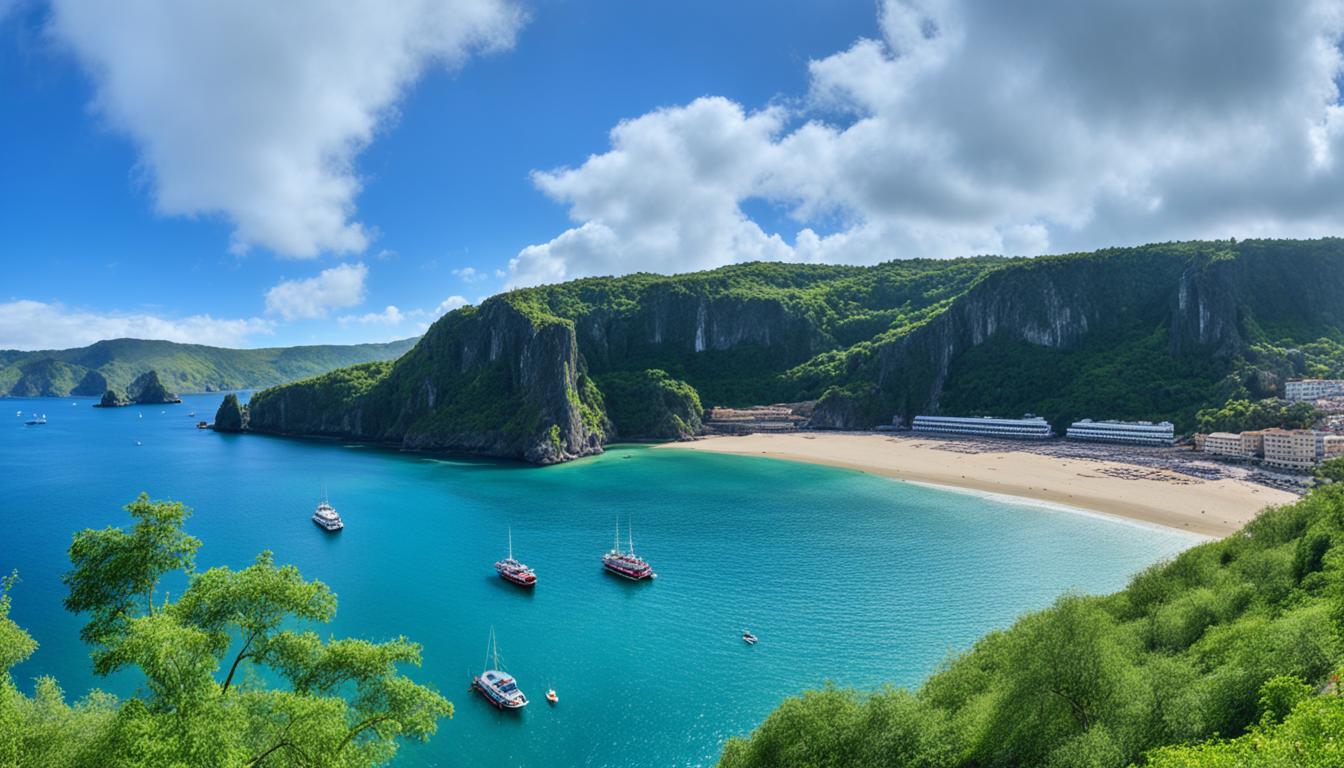The Canary Islands sit off the coast of northwestern Africa and are full of historical landmarks. Each island takes you back in time, showing us the past through its history. From the volcanic beauty of Teide National Park in Tenerife to the stunning architecture of San Cristóbal de La Laguna, these islands are perfect for history lovers.
Key Takeaways
- The Canary Islands have over 2,000 years of rich culture, thanks to the first settlers, the Canarian peoples.
- Places like El Julan Cultural Park and Belmaco Archaeological Park show the history of the Canarian indigenous peoples.
- UNESCO has named several Canarian sites, including La Laguna’s historic center and La Gomera’s whistled language, as World Heritage.
- The Canary Islands have many unique museums that keep their cultural heritage alive.
- The islands are known for their stunning natural landscapes, like Teide National Park and Roque Nublo, which are full of history and archaeology.
Islands with an Ancient Legacy
The Canary Islands have a long history, going back over 2,000 years. The first people here were the Guanches, who lived in isolation for nearly two thousand years. They were the indigenous Canarian peoples.
Today, you can still see the Guanches’ culture in many archaeological sites and monuments. For example, the Cenobio de Valerón in Gran Canaria has over 300 caves. These caves were where the natives kept their food.
Another site, the Risco Caído and the Sacred Mountains, shows us the Guanches’ spiritual and cultural life. It’s all in Gran Canaria.
Indigenous Canarian Heritage
There are more places that keep the Guanches’ heritage alive. The El Julan Cultural Park in El Hierro and the Belmaco Archaeological Park in La Palma are two of them. The Museum of Nature and Archaeology in Tenerife is another.
These sites show how smart and strong the Guanches were. They prove the importance of the ancient canarian archaeological sites.
| Site | Island | Significance |
|---|---|---|
| Cenobio de Valerón | Gran Canaria | More than 300 silos (caves) used by the Guanches for storing cereals |
| Risco Caído and the Sacred Mountains | Gran Canaria | Showcases the spiritual and cultural practices of the Guanches |
| El Julan Cultural Park | El Hierro | Preserves the indigenous Canarian heritage |
| Belmaco Archaeological Park | La Palma | Showcases the ingenuity and resilience of the Guanches |
| Museum of Nature and Archaeology | Tenerife | Preserves up to 140 remains and 12 complete mummies of the Guanches |
These ancient sites and monuments let us see into the lives of the indigenous Canarians. They remind us of the Guanches culture that once thrived here for centuries.
Canary Islands’ UNESCO World Heritage
The Canary Islands are filled with UNESCO World Heritage sites. These sites show the cultural and historical importance of the islands. The historic center of La Laguna in Tenerife is one such site. It was a model for many towns in the Americas.
This city has kept its original 15th-century town plan. It shows a mix of architectural styles like Mudéjar, Neoclassical, and Contemporary.
Another treasure is the Silbo Gomero, a whistled language from La Gomera. It was used by the Guanches for centuries. UNESCO recognized it as an Intangible Cultural World Heritage.
The Canary Islands also have the Risco Caido and the Sacred Mountains of Gran Canaria Cultural Landscape. This area is full of history and pre-Hispanic culture. It has troglodyte settlements and sacred temples that have stayed the same since the 15th century.
| UNESCO World Heritage Site | Key Facts |
|---|---|
| La Laguna Historic Center |
|
| Risco Caido and the Sacred Mountains of Gran Canaria Cultural Landscape |
|
| Silbo Gomero |
|
These UNESCO World Heritage designations highlight the historic Canarian architecture. They show the cultural significance and the preservation of the indigenous heritage. The Canary Islands are a true treasure of history and tradition.
canary islands historical sites
The Canary Islands are full of historical treasures. They have archaeological ruins, UNESCO landmarks, and cultural sites that show the islands’ rich past. The town of Betancuria in Fuerteventura was founded in 1404. The Castillo de San José in Lanzarote was built from 1776 to 1779. These sites show the diverse and interesting history of the Canary Islands.
The San Cristóbal de La Laguna in Tenerife is a UNESCO World Heritage site. It has a historic center with buildings from the 16th century. The Garajonay National Park in La Gomera is also a UNESCO site. It has ancient laurel forests and paths from before the Spanish came.
The Santa Catalina Castle in La Palma is from the 17th century. It helped protect the island from pirates. The Cueva Pintada in Gran Canaria has cave paintings that show the Guanches’ culture before the Spanish arrived. The Casa de Colón in Gran Canaria is a colonial mansion where Christopher Columbus may have stayed.
| Historical Site | Location | Significance |
|---|---|---|
| Betancuria | Fuerteventura | Oldest town in the Canary Islands, founded in 1404 |
| Castillo de San José | Lanzarote | Constructed between 1776 and 1779 by King Carlos III |
| San Cristóbal de La Laguna | Tenerife | UNESCO World Heritage site with a well-preserved historic center |
| Garajonay National Park | La Gomera | UNESCO World Heritage site with ancient laurel forests and pre-Hispanic paths |
| Santa Catalina Castle | La Palma | 17th-century castle that played a role in defending the island from pirates |
| Cueva Pintada | Gran Canaria | Cave paintings that offer insights into the Guanches’ pre-Hispanic culture |
| Casa de Colón | Gran Canaria | Colonial mansion where Christopher Columbus is believed to have stayed |
These are just a few of the many canarian archaeological ruins, historic canarian architecture, and canarian cultural landmarks in the Canary Islands. The islands are full of canary islands unesco heritage sites. They offer a chance to explore the rich history and culture of this beautiful region.
Canarian Museums: Preserving Heritage
The Canary Islands are full of cultural and historical treasures. They have museums that keep the region’s rich heritage alive. These places let visitors dive into the Canarian way of life.
Diverse Exhibitions
The Canarian Museum and the MUNA in Tenerife lead in preserving culture. They have canarian archaeological remains like mummies and artifacts. These show the life of the Guanches people.
There’s more to see than just ancient artifacts. You can explore museums on science, food, and art. The Museum of Science and the Cosmos in Tenerife talks about canarian scientific achievements. The Cheese Museum in Fuerteventura celebrates the island’s famous cheese.
The Las Hilanderas Silk Museum in La Palma shows off the canarian cultural exhibits. These museums are key parts of the Canarian culture.
“These museums are not just repositories of the past; they are living, breathing institutions that breathe life into the rich tapestry of Canarian culture.”
These canarian museums offer a journey through the islands’ history. They show what makes the Canary Islands special.
Artistic Canary Islands
The Canary Islands are famous for their art and artists. Óscar Domínguez, a surrealist painter, and Martín Chirino, a sculptor, both call the islands home. César Manrique, from Lanzarote, made a big impact with his art. His work is showcased at the César Manrique Foundation in Lanzarote.
The islands are also known for their beautiful architecture. Places like San Cristóbal de La Laguna show off the Canarian style. You’ll see colorful houses and unique balconies everywhere. This mix of art, architecture, and culture is what makes the Canary Islands special.
“The Canary Islands are a true haven for art and culture, where the past and present coexist in stunning harmony.”
Visiting the Canary Islands means diving into the art of Domínguez, Chirino, and Manrique. You’ll also see amazing architecture. It’s a journey that celebrates the islands’ unique culture.
Vibrant Canarian Festivals
Carnival Celebrations
The Canary Islands are full of life and color, thanks to their festivals. These events are key to the local culture. The Canarian carnival celebrations are a big deal. The Carnival of Santa Cruz de Tenerife is one of the biggest and most colorful in the world. It attracts many people every year.
But it’s not just Tenerife. The Corpus Christi festival in La Orotava is famous for its beautiful carpets made of sand and flowers. The Fiesta de la Rama in Agaete happens every four years. It celebrates the island’s aboriginal roots, showing off a unique part of Gran Canaria’s history.
These Canarian festivals are full of joy and color. People wear fancy costumes and dance to lively music. They show off the islands’ rich Canarian cultural traditions. They’re a must-see for anyone wanting to dive into the Canary Islands’ vibrant culture.
“The Canary Islands’ carnivals are a true feast for the senses, celebrating the islands’ heritage and bringing the community together in a joyous display of tradition and revelry.”
Authentic Canarian Traditions
The Canary Islands are known for their lively Carnival celebrations and traditional festivals called “romerías.” These festivals celebrate the islands’ farming roots. They feature music, dance, sports, crafts, and local food.
Some top romerías are the Bajada del Gofio in Agüimes and the Fiestas de la Rama in Agaete. The Romería del Pino in Teror and the Virgen del Socorro and San Isidro romerías in Güimar and La Orotava are also famous. These events let visitors see the rich culture of the islands.
Each island has its own music style, adding to the festive atmosphere. Traditional instruments and dances like the timple and tango make the culture vibrant.
Traditional sports and games are big in the Canary Islands too. Activities like Canarian wrestling and shepherd’s leaping have been enjoyed for years. There’s also “bolas canarias,” a game like petanque, played on special courts.

The Silbo Gomero, a whistled language, is recognized by UNESCO and used in La Gomera. The islands also protect historical sites like the ancient town of Betancuria and the Columbus House in Gran Canaria.
The Canary Islands offer a deep dive into their culture. From festivals and music to unique sports and languages, visitors can feel the islands’ strong heritage and the lively spirit of the Canarian people.
Musical Heritage
The Canary Islands are famous for their rich musical traditions. Each island has its own unique folk music style. You’ll find everything from lively “parrandas” to soulful “isas” and “malagueñas.”
These traditional tunes often feature local instruments like the “timple,” a stringed instrument, and the “chácaras,” castanets from La Gomera.
Timple and Silbo Gomero
Many museums across the islands celebrate this musical legacy. The Casa Museo del Timple in Lanzarote and the Néstor Álamo Museum in Gran Canaria are great examples. They highlight the history and making of the timple, a key instrument in canarian music.
The Silbo Gomero, a whistled language from La Gomera, is also celebrated. UNESCO has named it an Intangible Cultural World Heritage. It shows the deep connection of la gomera culture to its land.
| Canarian Traditional Instruments | Description |
|---|---|
| Timple | A traditional string instrument with a distinctive sound that is integral to the canarian music tradition. |
| Chácaras | A type of castanet used in the la gomera culture, often accompanying traditional dances and rhythms. |
| Silbo Gomero | A unique whistled language from the island of La Gomera, recognized by UNESCO as an Intangible Cultural World Heritage. |
“The musical heritage of the Canary Islands is a living testament to the region’s rich cultural tapestry, weaving together the rhythms of the past and the melodies of the present.”
Natural Wonders and Archaeological Sites
The Canary Islands are a mix of stunning natural sights and ancient ruins. They let visitors see the islands’ history and their beginnings. From the high volcanic peaks of Teide National Park in Tenerife to the ancient forests of Garajonay National Park in La Gomera, these places show the islands’ varied and beautiful landscapes.
Teide National Park is a UNESCO World Heritage Site with Spain’s highest peak, Mount Teide. It stands at 12,198 feet above sea level. This volcano shows the fiery past of the Canary Islands. Near it, the Fire Mountains in Timanfaya National Park in Lanzarote have red landscapes that look like the moon. These were made by volcanic eruptions in the 18th century.
The Garajonay National Park in La Gomera is full of an old laurel forest. It’s a piece of the lush vegetation that once covered the islands. This park is a UNESCO World Heritage Site and shows the islands’ natural variety and the strength of their ecosystems.
The Canary Islands also have many archaeological sites that tell us about the islands’ past. The Maipés Archaeological Park in Agaete, Gran Canaria, is huge and has almost five hundred tombs in lava. It shows how the Canarians buried their dead. The Arteara Necropolis in San Bartolomé de Tirajana has over a thousand burial mounds. The Tunte Settlement is one of the biggest cave complexes in the islands, with homes, storage, and paintings.
These canarian archaeological sites and canarian natural landmarks show the lasting legacy of the Canary Islands. They mix the islands’ geological history with the culture of its first people. Whether you like the volcanoes of Teide National Park or the ancient ruins, the Canary Islands offer a special experience.

“The Canary Islands are a true natural and cultural wonder, where the forces of nature have carved breathtaking landscapes and the indigenous people have left an indelible mark on the land.”
Conclusion
The Canary Islands are a mix of history, culture, and nature. They show us the archipelago’s deep past in a special way. You can see ancient ruins and UNESCO sites, enjoy lively festivals, and learn about the artistic traditions.
These islands are like a living museum. They invite you to dive into the history and traditions of this magical place. Whether you love history, are a student, or just like to explore, the Canary Islands are perfect for you.
With over 16 million visitors expected in 2023, the islands are still captivating people worldwide. They offer a chance to see the past and understand the Canarian cultural heritage better.
Mount Teide, Spain’s highest peak and the world’s third tallest volcano, is here. So is La Gomera, a UNESCO biosphere reserve. The islands mix history with nature beautifully.
You can see Guanche rock carvings, join in the carnival, or enjoy the islands’ music. The Canary Islands show the strength and spirit of the Canarian people.

